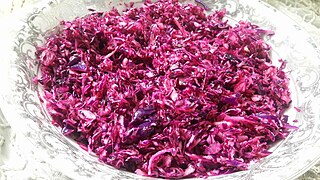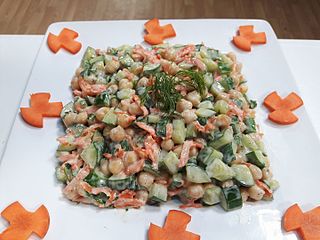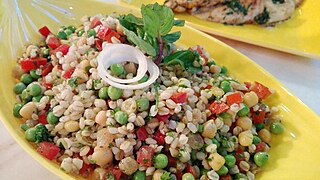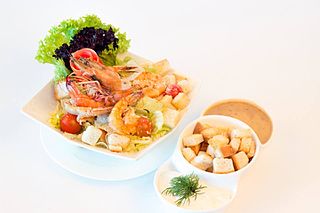
Baba ghanoush, also spelled baba ganoush or baba ghanouj, is a Levantine appetizer consisting of finely chopped roasted eggplant, olive oil, lemon juice, various seasonings, and tahini. The eggplant is traditionally baked or broiled over an open flame before peeling, so that the pulp is soft and has a smoky taste. It is a typical meze (starter) of the regional cuisine, often served as a side to a main meal and as a dip for pita bread.

Greek salad or horiatiki salad is a salad in Greek cuisine generally made with pieces of tomatoes, cucumbers, onion, feta cheese, and olives and dressed with salt, Greek oregano, lemon juice and olive oil. Common additions include green bell pepper or caper berries. Greek salad is often imagined as a farmer's breakfast or lunch, as its ingredients resemble those that a Greek farmer might have on hand.

Tabbouleh, also transcribed tabouleh, tabbouli, tabouli, or taboulah, is a Levantine salad made mostly of finely chopped parsley, with tomatoes, mint, onion, soaked uncooked bulgur, and seasoned with olive oil, lemon juice, salt and sweet pepper. Some variations add lettuce, or use semolina instead of bulgur.

Ful medames, or simply fūl, is a stew of cooked fava beans served with olive oil, cumin, and optionally with chopped parsley, garlic, onion, lemon juice, chili pepper and other vegetables, herbs, and spices. Ful medames is traditionally made in and served out of a large metal jug. It is notably a staple food in Egypt and is considered a national dish, especially in the northern cities of Cairo and Gizah. Fava beans can sometimes be also found in other cuisines in the Middle East, and Africa, though cooked differently.

Levantine cuisine is the traditional cuisine of the Levant, in the sense of the rough area of former Ottoman Syria. The cuisine has similarities with Egyptian cuisine, North African cuisine and Ottoman cuisine. It is particularly known for its meze spreads of hot and cold dishes, most notably among them ful medames, hummus, tabbouleh and baba ghanoush, accompanied by bread.

Sahawiqzhoug or zhug, is a hot sauce originating in Yemeni cuisine. In other countries of the Arabian Peninsula it is also called mabooj.

Palestinian cuisine consists of foods from or commonly eaten by Palestinians, whether in Palestine, Israel, Jordan, or refugee camps in nearby countries, or by the Palestinian diaspora. The cuisine is a diffusion of the cultures of civilizations that settled in the region of Palestine, particularly during and after the Islamic era beginning with the Arab Ummayad conquest, then the eventual Persian-influenced Abbasids and ending with the strong influences of Turkish cuisine, resulting from the coming of the Ottoman Turks. It is similar to other Levantine cuisines, including Lebanese, Syrian and Jordanian.
The cuisine of Kosovo is a representative of the cuisine of the Balkans and consists of traditional dishes by ethnic groups native to Kosovo. Due to Albanians being the main ethnic group in Kosovo, it is mainly an expression of Albanian cuisine, also adopting some elements of other Balkan countries.

Many cuisines feature eggplant salads and appetizers.

Middle Eastern cuisine or West Asian cuisine includes a number of cuisines from the Middle East. Common ingredients include olives and olive oil, pitas, honey, sesame seeds, dates, sumac, chickpeas, mint, rice and parsley, and popular dishes include kebabs, dolmas, falafel, baklava, yogurt, doner kebab, shawarma and mulukhiyah.

Bulgur, or burghul, is a cracked wheat foodstuff found in South Asian cuisine and West Asian cuisine.

Masmouta salad is an Arab salad, served with bread and consisted mainly of potatoes, carrots, peas, green gourd and beets as per choice.

Malfouf salad or cabbage salad, is a Lebanese salad, typically consisting of shredded cabbage, lemon juice, olive oil, garlic, salt and dried mint.

Chickpea salad, sometimes called hummus salad, using the Arabic word for 'chickpea', is a salad in Arab cuisine. It consists of whole cooked chickpeas, lemon juice, garlic, tahini, salt, olive oil, and cumin.

Wheat salad, is an Arab salad which typically consists of wheat, corn, tomatoes, carrots, cucumber pickles, lemon, parsley, olive oil and salt.

Rubiyan salad, is a type of Arab salad, typically made of shrimp, tomato. mayonnaise, lettuce leaves, ketchup, hot sauce, mustard, lemon juice, and salt.

Sweet potato salad is an Arab salad, made typically of sweet potato, onion, olive oil, mashed garlic, salt, ground pepper, grated ginger, black pepper, cinnamon sticks, raisins, coriander, ground sugar, and water. It is very popular in the Arab world, especially in the Maghreb as well in the Levant, specifically in Lebanon.

Mutabbaq Samak a rice-based dish popular in the Arab states of the Persian Gulf and in some southern cities in Iraq. It is basically spiced fried fish, usually Stromateus and caramelized onions served over rice that is cooked in well-spiced fish stock. Fish can be whole fish or fish filet. It is considered a national dish in Iraq and Kuwait where the dish is pronounced in both of their colloquial dialects as "im'tabbag simach". In Arabia, raisins, cardamom and tomato broth are added too.

Qarymutah or qrymutah is a little-known popular dish from rural areas of central Syria, totally vegetarian, consisting of a mixture of bulgur with vegetables and seasonings wrapped in grape leaf. Some people in Salamiyah, where this dish originates from, say that its name comes from the time when the Qarmatians ruled. It was formerly known as "poor man's food". Depending on the place, it may also be known as farifa (الفَريفيرة), muqrita (المقَيريطة) or mniqiah (المنيقريعة).

































